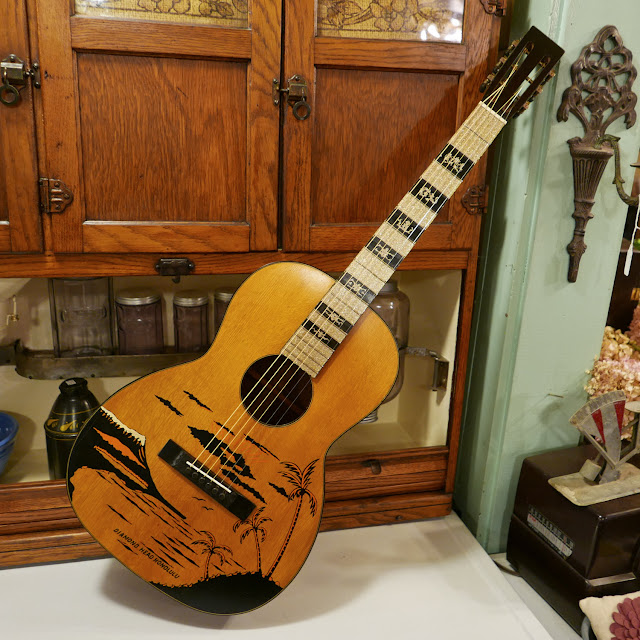1930s Regal Diamond Head 00-Size Flattop Guitar
I've had the luck to work on three Diamond Head guitars, now. Like the last one I had through, this one is also very clean and only needed "glorified setup" work. These guitars are sized like 00 12-frets and measure 14 1/8" across the lower bout. The top is solid spruce and ladder-braced and the back and sides are mahogany. Like most Regals of the '30s, the neck is poplar and underneath the fancy trim, the bridge and fretboard are "ebonized" maple.
The best bits of the guitar are its open, woody, full-on Regal ladder-braced sound (these are lightly-built and sound gorgeous for fingerpicking) and, of course, the awesome stencil-and-extra-paint artwork on the front (as well as the gold-sparkle celluloid fretboard material). The only downside of a guitar like this for some players might be the 1 7/8" nut width, flat-profile fretboard, and bigger V-shaped neck profile.
Work on this included fret seating (glued-in), a fret level/dress, bridge shave and saddle-slot-recut to a compensated angle, and general setup after that. It came to me in overall excellent shape and has no cracks and a good neck angle. It's playing on-the-dot with 3/32" EA and 1/16" DGBE action at the 12th fret and strung with 50w-11 strings.
The original nut is bone.
The fretboard is stained maple, though Regal put a gold-sparkle celluloid veneer over it and then stenciled the interesting black "markers" over it. These blocky/tallish brass frets aren't for everyone, but after the level/dress and seating they're in good order.
To get the action right and make a new saddle slot on a compensated angle, I had to shave the bridge down a bit. Because it's maple, it's then brightly "natural" on top. I've figured out a way to simulate the painted-plus-finished old Regal-style of "ebonization," however.
I start by brushing and rubbing-in India ink. Then I use an automotive touch-up paint that gives the effect of the brushed-on varnish used on these. After that dries, I buff it down a bit and then gloss it back up with wipe-on poly finish. The end result matches the original finish pretty closely in antiqued vibe and "grain-stick-up."
I made two bone, drop-in saddles for this guitar -- one from the original bone saddle and one from the remnants of an old Martin saddle -- for summer/winter action height adjustments.
The black, wood pins are original equipment.
The orange and black work seems to be stenciled, while the white paint for the snow was added after-the-fact.
Nice-looking mahogany, huh?






















Comments